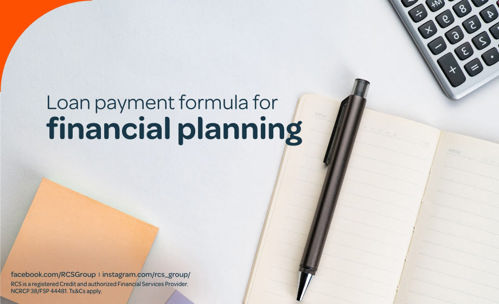Loan Payment Formula For Financial Planning
10 AUGUST 2023
Let’s get on-top of our finances and stay on top of them for the rest of the year by planning. This can be the year you achieve financial wellness
The first thing to do is identify the type of loan you’re applying for.
When you get a loan from a lender, the sum of money you receive is called the principle. Then interest is charged on that principal amount. Making your total owing, principal plus interest. Typically, your monthly loan payments will be divided into equal instalments during the loan's term. Check out our article on Types of Loans and When to Use Them to learn more.
How you calculate your repayments will depend on the type of loan you get. Below we’ll touch on the 3 you are most likely to encounter.
Interest-only loans.
Only interest is paid on interest-only loans in the early years.
Amortising loans.
During the amortisation term, you're paying both the principle and the interest. For example, if you have a five-year car loan, you may start off paying 25% toward the principle and 75% toward interest. You pay interest and principal on your loan, but your monthly payment amount is likely to remain the same.
Credit card loans.
As long as you pay your credit card on time, you have access to a revolving line of credit that may be used again and again. In the event that you miss a payment and carry debt over to the following month, you may be charged interest.
So how do you calculate your repayments?
It’s important to note that the following amounts and percentages are for illustration purposes only.
The example we’ll use is as follows: R150 000 loan at a 7.5% annual interest rate for 5 years after making a R15 000 down payment.
The formula:
A = P (r (1+r)^n) / ( (1+r)^n -1 )
Where:
- A = Payment amount per period
- P = Initial principal or loan amount (in this example, R150 000)
- r = Interest rate per period (in our example, that's 7.5% divided by 12 months)
- n = Total number of payments or periods
- P = R150 000
- r = 7.5% per year / 12 months = 0.625% per period (0.00625 on your calculator)
- n = 5 years x 12 months = 60 total periods
So your monthly payment would be:
A = R150 000 (0.00625 x (1 + 0.00625)^60) / ( (1 + 0.00625) )^60 – 1) A = R150 000 (0.000625 x 1.45329) / (1.45329 - 1) A = R150 000 (0.00908306 / 0.45329) A = R150 000 (0.02003808) A = R 3005,71
If you’ve just felt a bit dizzy from all this algebra, consider using a loan calculator, such as My Financial Help
Here’s how to pay less on your loan
- Shop around, get multiple quotes. Just make sure it is within the 14–30 day period so it does not influence your credit score. When you're shopping around for the best rate, you might be surprised to find out that a smaller financial institution offers lower interest rates on a personal loan.
- Pay off any current debt, or at least as much as you can before applying for a new loan.
- Set up automatic payments. If you set up auto-pay for your personal loan, car loan, or mortgage, you might be able to lower your interest rate.
- Improve your credit score.
This is the year to be financially savvy - and reach financial wellness. Good luck!
MORE ARTICLES ABOUT
RELATED ARTICLES

Education
28 AUGUST 2025
SA Research: How Parents Impact a Child’s Financial Intelligence

Education
12 JUNE 2025
Cultivating Tomorrow's Leaders: Equipping Young South Africans for Life’s Challenges

Education
28 MARCH 2025
